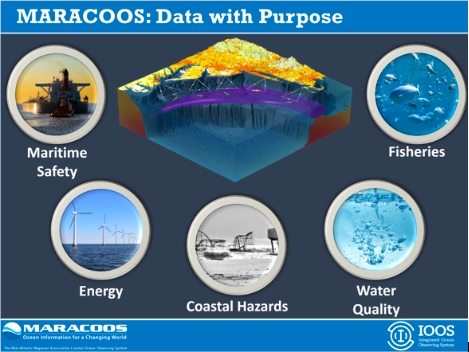Title: Mid-Atlantic Regional Association Coastal Ocean Observing System (MARACOOS): Preparing for a Changing Mid-Atlantic
Funding Agency: NOAA Integrated Ocean Observing System (IOOS)
Project Lead: Scott Glenn
Partners: MARACOOS, University of Massachusetts Dartmouth, University of Delaware, RPS, University of Connecticut, University of Rhode Island, Caribbean Wind LLC, Virginia Institute of Marine Sciences/William and Mary, Old Dominion University, University of Maryland, Woods Hole Oceanographic Institute
Period of Performance: June 2016 – May 2021
Total Budget: $20,000,000
Project Summary:
Diverse Regional Needs on a Changing Planet: The Mid-Atlantic Bight (MAB) extends 1000 km alongshore, from Cape Cod, MA to Cape Hatteras, NC. It includes five major estuarine systems and a wide continental shelf cut by a deep cross-shelf valley and multiple shelf-break canyons. The region encompasses 10 states, the District of Columbia, 107 congressional districts and ~78M people (25% of US population). The nation’s highest coastal population density makes increasingly competing demands for marine and coastal resources. Ports in the region handle 25% of the total U.S. waterborne commerce, and include the nation’s largest petroleum product hub and the world’s largest Naval base. The MAB is a dynamic boundary between the less variable waters to our north and south, with complex seasonal physical dynamics resulting in a highly variable 3-D thermal structure. These dynamics structure shellfish and migratory fish habitats that support both commercial and recreational fisheries, and directly impact our weather. Developed watersheds and urban estuaries, impacted by a century of industrialization and growing coastal populations, degrade coastal water quality and diminish recreational economies. Inundation driven by tropical storms and northeasters are year-round threats to the large populations that live on the broad coastal plain. While the region’s electrical power grid is the most congested in the nation, the high population density, reliable winds, and wide continental shelf combine to support the nation’s nascent offshore wind energy development projects.
But warming of the climate system is unequivocal (IPCC, AR5, 2015). Present and future generations will be challenged by its accelerating global impacts, including melting of land and sea ice, rising sea levels, ocean acidification (OA), and deoxygenation (hypoxia), and more frequent extreme weather. Improved knowledge of the trends and variability of our changing environment is required to address the challenges of energy, food, water and economic security and resiliency on regional, national and international scales. In the Mid-Atlantic, global sea level rise, along with coastal subsidence from the last glacial retreat, combine to produce a regional hot-spot for rising sea levels, creating a higher baseline for land falling hurricanes and devastating northeasters. Climatic warming and OA are altering MAB fish and shellfish habitats. The Mid-Atlantic’s dense population further increases the region’s economic sensitivity to climate change, where, for example, new rainfall patterns and more frequent extreme weather conditions are impacting homes, businesses, farms and reservoirs.
A Plan for the Future: Continuing to build on accomplishments and lessons learned, MARACOOS will again bring together over 30 investigators from over 12 institutions for our third 5-year maintenance and development cycle with a focus on products. We propose to: (a) enhance the RA management team to better support the requirements of certification; (b) maintain our existing observing infrastructure, with a surge capacity capable of responding to extreme events, while continuing to expand our ability to deliver data quality consistent with QARTOD; (c) expand our data management and curating activities to entrain even more external data providers into the common operating picture provided by our Data Explorer technologies; (d) focus on implementing the results of a metric-informed user-driven prioritization of data-assimilative prediction models for specific purposes; (e) integrate and grow the outreach, engagement and education team to enhance new product development, awareness, and use with targeted user communities; and (f) establish entrepreneurial innovation teams to grow future cross-cutting activities that broaden support for and enhance responsiveness to our 5 user themes. This will continue to foster the MARACOOS mission—to seek, integrate, share and apply new knowledge and understanding of our coastal ocean—and will enable us to maintain our long-standing commitment to providing integrated ocean information for a changing world.

